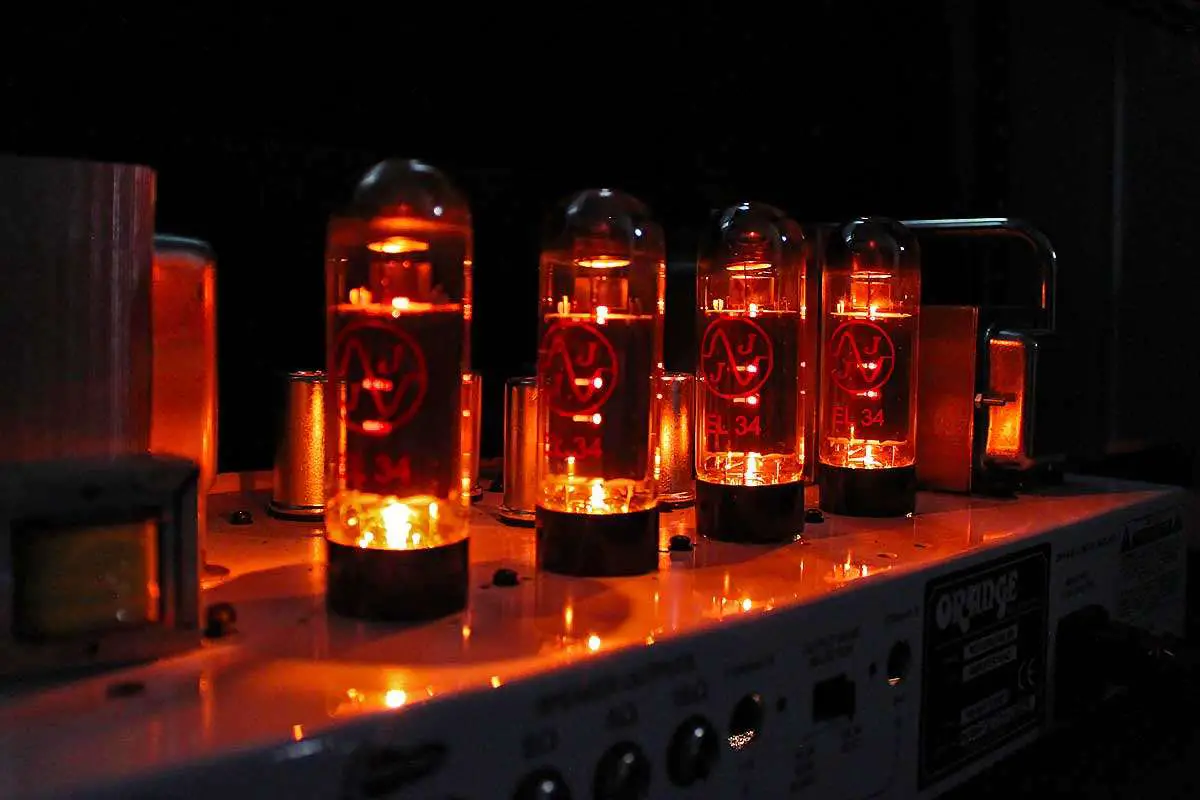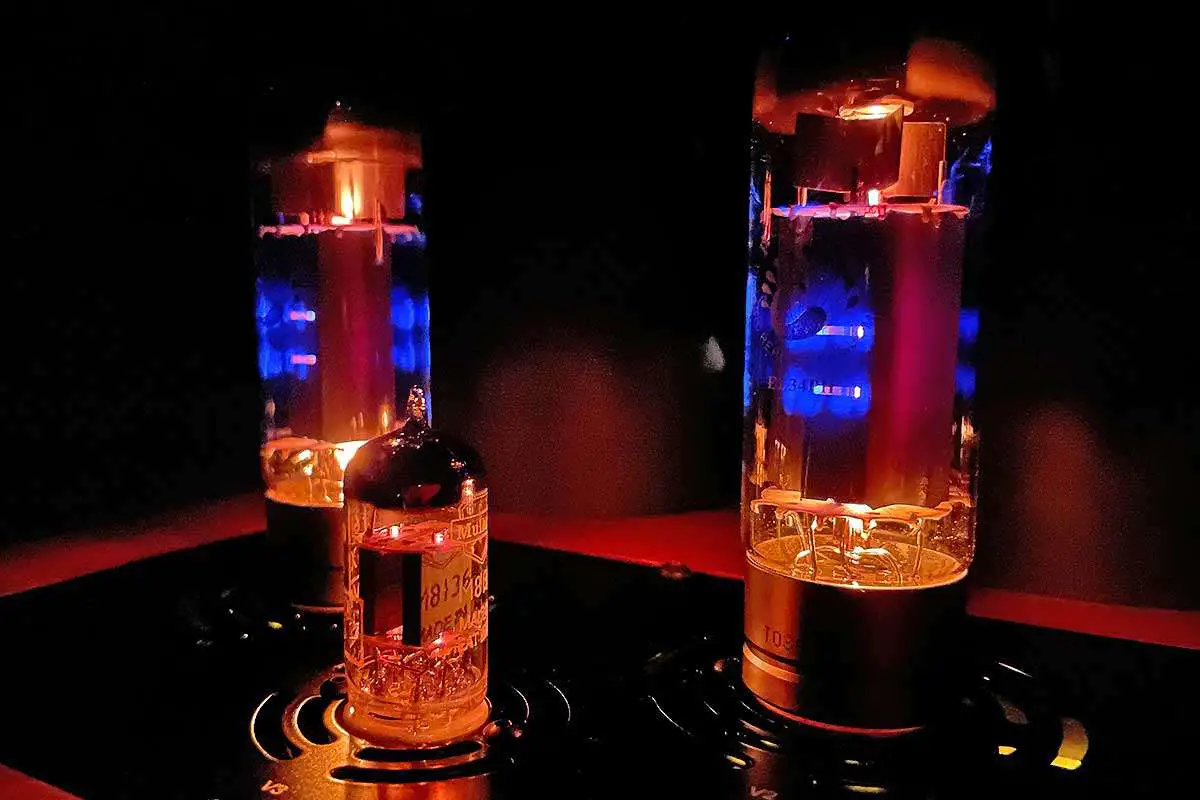When you’re diving into the world of guitar amplifiers, the choice of vacuum tubes becomes a pivotal factor in shaping your sound. When it comes down to EL34 vs KT77, they are two types of power vacuum tubes often used in guitar amplifiers. Both of these tubes are historically rooted in the quest for distinctive tone and have played critical roles in the evolution of amplifier design.
The EL34 is renowned for its crisp, aggressive midrange and is a staple in British amplifiers, particularly contributing to the classic rock tones that emerged in the 1960s and 70s. It’s known for providing a characteristic glassy top-end and a tight response that has shaped the sound of many legendary records. On the other hand, the KT77, which can be considered a relative of the EL34, offers a slightly different flavor. It’s revered for its round and balanced tonal qualities, with a full low end and smoother mids that suit modern genres well.
Yet, despite their differences, both the EL34 and KT77 are celebrated for their rich harmonics and dynamic response. As you explore these options for your guitar amplifier, understanding how each can influence your sound will help you tailor your rig to meet your musical needs and preferences. Whether you’re chasing vintage vibes or modern tones, knowing the nuances between the EL34 and the KT77 is crucial for any guitarist looking to customize their amplifier’s voice.

History and Origin of EL34 and KT77 Tubes
You may be intrigued by the rich history of the vacuum tubes in your guitar amplifier. Understanding the development of the Mullard EL34 tubes along with the genesis of the Gold Lion KT77 tubes provides insight into their distinctive characteristics and usage in audio amplification.
Development of Mullard EL34 Tubes
The Mullard EL34 is a power pentode originally developed by the Mullard Company in the early 1950s. Known for its characteristic glass envelope and brown base, it quickly became popular in Europe and later throughout the world. Its ability to produce high-quality audio with exceptional power handling made it a staple for high-fidelity applications and guitar amplifiers.

Genesis of Gold Lion KT77
On the other hand, the Gold Lion KT77, manufactured by the Marconi-Osram Valve Co., a subsidiary of GEC, was introduced as a direct alternative to the EL34. Though it shares a similar pin configuration with the EL34, the KT77 was designed to provide a different harmonic response, potentially offering a smoother midrange, which some guitarists favor. This tube is known for its characteristic performance stability and durability.
Technical Specifications and Design
When evaluating the technical aspects of guitar amp tubes, you should focus on their design specifications, which directly impact tone and performance. These specifications include comparisons between preamp and power tubes, as well as differences within the pentode family, particularly the EL34 and KT77 tubes.
Understanding Vacuum Tubes and Pentodes
Vacuum Tubes: At the core, vacuum tubes, essential components in vintage and modern tube amplifiers, amplify the signal from your guitar. These tubes work by controlling the flow of electric current through a vacuum in a sealed glass tube. The pentodes, such as the EL34 and KT77, are a type of power tube known for their high power output and are distinct from triodes due to an additional third electrode called the suppressor grid.
Pentodes: Among these, the EL34 tubes are renowned for their characteristic glassy midrange and tight lows, suitable for rock and blues genres. Additionally, EL34 tubes are interchangeable with 6CA7 tubes, providing similar sonic qualities. On the other hand, KT77 tubes are less common but offer a unique tonal palette with smoother mids and a broader frequency response.
Comparing Power and Preamp Tubes
Power Tubes: Several types of power tubes exist, including the 5881, 6550, and KT77. The 5881 and 6550 are recognized for their robust headroom and heavier bass response, respectively. In comparison, EL34 and KT77 tubes differ in construction and tonality. EL34s deliver a classic British sound with rich harmonic content, while KT77s offer a more linear response with tighter control.
Preamp Tubes: Preamp tubes shape your sound’s initial amplification and are influential in determining the amp’s overall character. Unlike power tubes, which drive the amp’s output, preamp tubes, such as the 12AX7, manage tone and gain staging.
When choosing between EL34 and KT77 tubes, consider the desired tone, the amp’s existing circuitry, and compatibility with your amp. Whether seeking articulate highs for articulate leads or robust lows for chunky rhythms, your tube selection is key to achieving the sound that defines your musical expression.
Tonal Characteristics & Sound Quality
When comparing EL34 and KT77 tubes in guitar amplifiers, you will find distinct differences in their harmonics, headroom, and frequency responses that shape the sound you produce. Each tube infuses its unique character into your guitar’s tone, affecting the nuances of your sound quality.
Harmonics and Dynamics
EL34 tubes are renowned for their expressive midrange and rich harmonic overtones. They tend to offer a grittier texture, which can bring a sense of warmth and complexity to your guitar’s sound. On the other hand, KT77s are generally clearer and can provide a more linear harmonic distribution, giving you a broader sonic palette to work with. This characteristic keeps your chords intact and dynamic, even when heavily driven, allowing for a versatile performance across various genres.
Headroom and Distortion
Your amp’s headroom is how loud it can get before it begins to distort. EL34 tubes naturally have a lower headroom, which means they’ll introduce distortion at lower volumes. This can be beneficial if you’re looking for that classic, crunchy Marshall tone without blasting the volume. KT77 tubes, conversely, offer higher headroom, allowing you to push your amp harder while maintaining clarity and delay the onset of distortion. The KT77’s ability to handle higher volumes with less compression makes them ideal for playing styles that require clean and distinct articulation.
Frequency Response and EQ Profiles
The frequency response of EL34 tubes is notably mid-focused, providing a punchy and aggressive midrange that can cut through a mix. Their EQ curve lends itself well to rock and metal genres where mids are crucial. KT77 tubes offer a more balanced EQ profile, which supports a full-spectrum sound. They deliver tighter bass and crisp, clear top-end response, yielding greater gain before feedback. Whether you’re strumming clean chords or diving into a high-gain solo, KT77 tubes help preserve the dynamic range and clarity of your playing across all frequencies.
Compatibility and Applications
When considering the compatibility and specific applications of the EL34 and KT77 tubes, you’ll find that your choice can greatly influence the tone and performance of your guitar amp. Each tube type brings its own character to the table and aligns with various musical intentions.
Amp and Guitar Pairings
EL34: Known for their midrange growl, EL34 tubes are often the go-to for classic rock guitarists. They pair well with amplifiers designed for a British sound, like the Marshall series, delivering a distinctly aggressive and crunchy tone.
- Compatible Amps: Marshall, Hiwatt
- Ideal Guitars: Gibson Les Paul, Fender Stratocaster
KT77: Offering a more linear response and tight lows, KT77s can be considered a more versatile variant fitting a wide range of amplifiers. Your guitar’s natural tone will be more apparent, making KT77s a smart choice for those who switch between playing styles.
- Compatible Amps: Modern Marshall, Mesa Boogie
- Ideal Guitars: PRS Custom 24, Ibanez RG
Musical Genres and Styles
Jazz: The KT77 can provide the necessary headroom for clean jazz tones, allowing your archtop guitar to resonate with clarity and fullness.
- Jazz Guitar Amplifiers: Roland JC-120, Fender Twin Reverb
Rock: For rock music, the EL34 tube might be your preference because of its signature crunch and mid-forward sound that cuts through the mix.
- Rock Guitar Amplifiers: Marshall Plexi, Orange Rockerverb
Classical and Vocals: While not typically the realm of guitar amps, if you’re miking a classical instrument or vocals through a guitar amplifier for a unique effect, a KT77 with its flatter response can provide the fidelity and clarity needed.
- Applicable Amps: Vox AC30, Fender Deluxe Reverb
In mapping your tone to your musical landscape, consider these pairings as starting points to cater to your specific audio applications.
Valve Amplifier Tube Comparisons
Want to learn more about guitar amp tubes? Explore the nuanced distinctions between preamp and power tubes, including popular matchups like ECC83 vs 12AX7 and EL34 vs KT88, as we unravel the sonic differences that shape your guitar’s unique voice.
| Tube Types | Application |
|---|---|
| ECC83 vs 12AX7 | Preamp Tubes |
| 12AU7 vs 12AX7 | Preamp Tubes |
| 6L6 vs EL34 | Power Tubes |
| 6L6 vs KT66 | Power Tubes |
| 6L6 vs 6V6 | Power Tubes |
| 5881 vs 6L6 | Power Tubes |
| EL34 vs EL84 | Power Tubes |
| EL34 vs KT88 | Power Tubes |
| EL34 vs KT77 | Power Tubes |
| EL34 vs KT66 | Power Tubes |
| 6V6 vs EL84 | Power Tubes |
